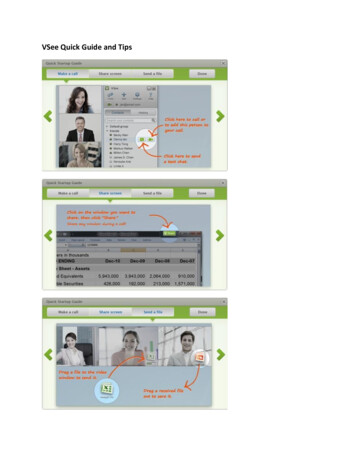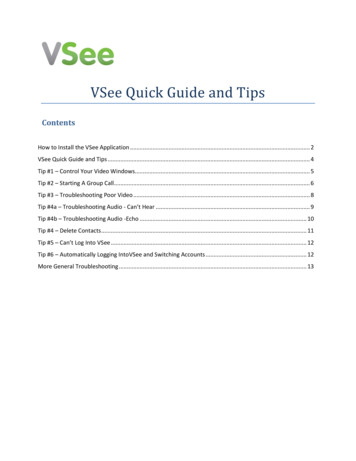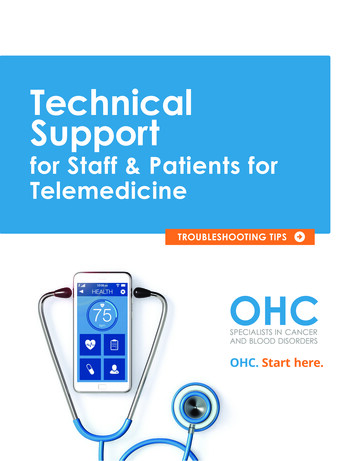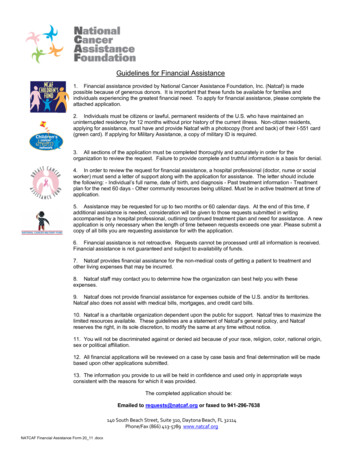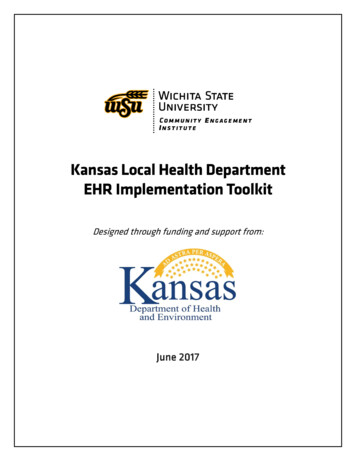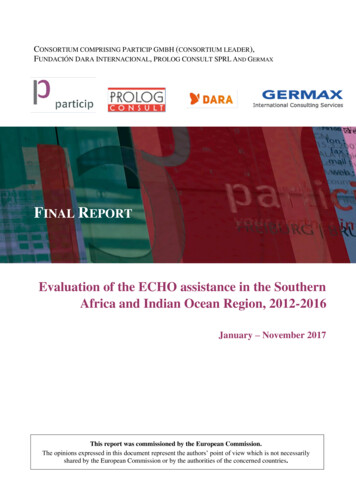
Transcription
CONSORTIUM COMPRISING PARTICIP GMBH (CONSORTIUM LEADER),FUNDACIÓN DARA INTERNACIONAL, PROLOG CONSULT SPRL AND GERMAXFINAL REPORTEvaluation of the ECHO assistance in the SouthernAfrica and Indian Ocean Region, 2012-2016January – November 2017This report was commissioned by the European Commission.The opinions expressed in this document represent the authors’ point of view which is not necessarilyshared by the European Commission or by the authorities of the concerned countries.
Neither the European Commission nor any person acting on behalf of the Commission isresponsible for the use which might be made of the following information.Europe Direct is a service to help you find answersto your questions about the European Union.Freephone number (*):00 800 6 7 8 9 10 11(*) The information given is free, as are most calls (though some operators, phoneboxes or hotels may charge you).More information on the European Union is available on the Internet (http://europa.eu).Luxembourg: Publications Office of the European Union, 2017ISBN: 978-92-79-74448-8DOI: 10.2795/546723 European Union, 2017
Implementing Consortium Partners:Particip, Germax, and PrologThe Evaluation Team (Experts):Lezlie C. Morinière (TL)Borja Cuervo AlonsoMunhamo ChisvoManuel FürstosAtusaye MwalwandaBelmiro NhamithamboGinna Rakotoarimanana
Evaluation of the ECHO assistance in the Southern Africa and Indian Ocean Region, 2012-2016 – ECHO/ADM/BUD/2016/01204Table of ContentsTable of Figures . iiiList of Abbreviations and Acronyms . ivAbstract . ixExecutive Summary . x1Purpose and scope of the evaluation . 12Background . 3345672.1The SAIO region . 32.2ECHO in the SAIO region. 6Methodology and tools . 93.1Methodology . 93.2Instruments and Tools . 10Findings . 134.1EQ1: Relevance/Needs-Based . 134.2EQ2: Relevance/Design . 184.3EQ3: Coherence . 244.4EQ4: Added-Value . 304.5EQ5: Effectiveness . 334.6EQ6: Cost Efficiency/ Effectiveness . 384.7EQ.7: Advocacy, Communication and Uptake . 46Conclusions . 525.1EQ1: Relevance/Needs-Based . 525.2EQ2: Relevance/Design . 535.3EQ3: Coherence . 545.4EQ4: Added-Value . 545.5EQ5: Effectiveness . 555.6EQ6: Cost Efficiency/Effectiveness . 565.7EQ7: Advocacy, communication and sustainability . 56Recommendations . 586.1General recommendations organized by EQ . 586.2Three main strategic recommendations . 61Annexes. 64Annex A: Terms of Reference . 65Annex B: Bibliography . 84Annex C: List of People Consulted. 87Annex D: List of Communities visited . 90Annex E: Case Study 1 - Health and Epidemics . 91Annex F: Case Study 2 - Food Assistance . 101Final ReportParticip Page i
Evaluation of the ECHO assistance in the Southern Africa and Indian Ocean Region, 2012-2016 – ECHO/ADM/BUD/2016/01204Annex G: Case Study 3 - Urban DRR . 107Annex H: Method/Instruments: KIIs, Perception Survey . 113Annex I: Analysis Outputs . 118Annex J: Main factors limiting the success of the projects funded . 127Annex K: Proposal for the dissemination of the evaluation results . 128Annex L: Statement about the validity of the evaluation results . 129Annex M: Note de synthèse . 130Annex N: Síntese . 137Page ii ParticipFinal Report
Evaluation of the ECHO assistance in the Southern Africa and Indian Ocean Region, 2012-2016 – ECHO/ADM/BUD/2016/01204Table of FiguresFigure 1: Index for Risk Management . 3Figure 2: Timeline of SAIO ECHO - Humanitarian Events and Funding Decisions . 5Figure 3: Volume of funding per type of decision . 6Figure 4: 19 funding decisions aligned to IDRM . 7Figure 5: Geographic distribution of funded projects . 8Figure 6: Mixed Methods across the main phases . 9Figure 7: Final Method Status . 9Figure 8: Coverage of Key Informant Interviews . 10Figure 9: Profile of Perception Survey Respondents (KII) . 11Figure 10: Annual distribution of funding between Type of Threat . 15Figure 11: EQ1 Evidence Summary . 17Figure 12: Annual distribution of funding between DRR/Preparedness and Response/Recovery . 19Figure 13: EQ2 Evidence Summary . 23Figure 14: Humanitarian Investment in SAIO (ECHO and the greater international community) . 27Figure 15: EQ3 Evidence Summary . 29Figure 16: EQ4 Evidence Summary . 32Figure 17: EQ5 Evidence Summary. 37Figure 18: TCTR SAIO Averages with analysis . 41Figure 19: Evidence Summary “Minimum package of cost-effectiveness JCs, indicators andtools” . 45Figure 20: EQ7 Evidence Summary . 51Figure 21: Nearly Consistent Message through Time . 61Figure 22: Specific Recommendations, Regain Focus . 62Figure 23: Specific Recommendations: central DRR governance . 62Figure 24: Specific Recommendations: LRRD . 63Final ReportParticip Page iii
Evaluation of the ECHO assistance in the Southern Africa and Indian Ocean Region, 2012-2016 – ECHO/ADM/BUD/2016/01204List of Abbreviations and AcronymsACAPSAssessment Capacities ProjectACPAfrica, Caribbean and Pacific Group of StatesADEAide à la Décision ÉconomiqueAGOAngolaAIDSAcquired Immune Deficiency SyndromeALNAPActive Learning Network for Accountability and PerformanceBNGRCNational Bureau of Risk and Disaster ManagementBRUBrusselsBWABotswanaCARECooperative for Assistance and Relief EverywhereCCAClimate change adaptationCDCCenters for Disease Control and PreventionCFWCash-for-WorkCHSCore Humanitarian StandardCMCrisis ModifierCOMUnion of the ComorosCOOPICooperazione InternazionaleCOSACAConsortium composed of humanitarian organisations: Concern, Oxfam, Save theChildren and CARECPCChild Protection in CrisisCPGUCellule de Prévention et Gestion des UrgencesCREDCentre for Research on the Epidemiology of DisastersCS/CSOsCivil Society OrganisationsCVCurriculum VitaeDADecision AnalysisDACDevelopment Assistance CommitteeDEVCODG Europe Aid Development & CooperationDFIDUK Department for International DevelopmentDGDirectorate-GeneralDG ECHODirectorate-General for European Civil Protection and Humanitarian AidOperationsDIMSURTechnical Centre for Disaster Risk Management and Urban ResilienceDiPECHODisaster Preparedness ECHO programmeDODesk OfficerDoDMADepartment of Disaster Management AffairsDRDesk ReviewPage iv ParticipFinal Report
Evaluation of the ECHO assistance in the Southern Africa and Indian Ocean Region, 2012-2016 – ECHO/ADM/BUD/2016/01204DREFDisaster Relief Emergency FundDRM/RDisaster Risk Management/ReductionECEuropean CommissionECHODirectorate-General for European Civil Protection and Humanitarian AidOperationsECHO/NBOECHO regional office in NairobiEDFEuropean Development FundEDRISEuropean Emergency Disaster Response Information SystemEMDATCentre for Research on the Epidemiology of Disasters (Emergency Database)EQEvaluation QuestionEUEuropean UnionEUDELEU DelegationEWSEarly Warning SystemFAOFood and Agriculture OrganizationFCAForgotten Crisis AssessmentFGDFocus Group DiscussionsFMDFoot and Mouth DiseaseFSField StudiesFTSFinancial Tracking ServiceGAVIGlobal Alliance for Vaccines and ImmunizationsGBVGender Based ViolenceGDGeneral documentsGFDRRGlobal Facility for Disaster Reduction and RecoveryGmbHGesellschaft mit beschränkter HaftungGoAGovernment of AngolaGovGovernmentHABITATUnited Nations Human Settlements ProgrammeHARHumanitarian Aid RegulationHCTHumanitarian Country TeamHFAHyogo Framework for ActionHFPHumanitarian Focal PointHIPHumanitarian Implementation PlanHIVHuman Immunodeficiency VirusHOPEEC database (Humanitarian Office Programme Environment)HQHeadquarterICCOInterchurch Organisation for Development CooperationICPMJoint Advocacy Initiative for DRMFinal ReportParticip Page v
Evaluation of the ECHO assistance in the Southern Africa and Indian Ocean Region, 2012-2016 – ECHO/ADM/BUD/2016/01204IDPInternally Displaced PersonIDRMIntegrated Disaster Risk ManagementILIntervention LogicInfoRMIndex for Risk ManagementINGCNational Institute of Disaster ManagementINGOsInternational Non-Governmental OrganizationIOMInternational Organization for MigrationIOInternational OrganizationIPImplementing PartnerIPCIntegrated Phase ClassificationIRMIntegrated Risk ManagementISDRInternational Strategy for Disaster ReductionJCJudgement CriteriaJEFAPJoint Emergency Food Aid ProgrammeJRCJoint Research CentreKI/KIIKey Informant/InterviewsLACLatin America and the Caribbean RegionLoELevel of EffortLRRDLinking Relief, Rehabilitation and DevelopmentLSALean Season AssistanceLSOLesothoM&EMonitoring and EvaluationMAUMauritiusMDGMadagascarMIPMultiannual Indicative ProgrammeMoHMinistry of HealthMOZMozambiqueMSMicrosoftMSFMédecins Sans FrontièresMVACMalawi Vulnerability Assessment CommitteeMWIMalawiNBNota beneNAMNamibiaNDMONational Disaster Management OfficeNFINon-Food ItemNIPNational Indicative ProgrammeNGONon-Governmental OrganizationPage vi ParticipFinal Report
Evaluation of the ECHO assistance in the Southern Africa and Indian Ocean Region, 2012-2016 – ECHO/ADM/BUD/2016/01204OObservationOCHAOffice for the Coordination of Humanitarian Affairs (UN)OECDOrganisation for Economic Co-operation and DevelopmentOFDAOffice for Foreign Disaster AssistancePD/CANPost-Disaster / Conflict needs assessmentPNSPartner National SocietiesPPTMicrosoft Power PointPRAGPractical Guide to Contract Procedures for EU External ActionsPSPerception SurveyQAQuality AssuranceRAResearch AssistantRCResident CoordinatorRSARepublic of South AfricaSADCSouthern African Development CommunitySAIOSouthern Africa and Indian Ocean RegionSETSANTechnical Secretariat for Food Security and NutritionSEYRepublic of SeychellesSFDRRSendai Framework for Disaster Risk ReductionSIDASwedish International Development Cooperation AgencySIMSubscriber Identification ModuleSLR/ASystematic Literature Review/AnalysisSMSShort Message ServiceSPASystematic Portfolio AnalysisSRPStrategic Response PlanSWZKingdom of SwazilandTCTRTotal Cost-Transfer RatioTATechnical Assistance / Technical AssistantTLTeam LeaderT-MatrixTriangulation MatrixToRTerms of ReferenceUNUnited NationsUNHCRUnited Nations High Commissioner for RefugeesUNICEFUnited Nations Children’s FundUNISDRUN Office for Disaster Risk ReductionUNOCHAUnited Nations Office for the Coordination of Humanitarian AffairsUSAIDUnited States Agency for International DevelopmentFinal ReportParticip Page vii
Evaluation of the ECHO assistance in the Southern Africa and Indian Ocean Region, 2012-2016 – ECHO/ADM/BUD/2016/01204UNEGUnited Nations Evaluation GroupVSLVillage Savings and LoanWASHWater, Sanitation and HygieneWBWorld BankWFPWorld Food ProgrammeWHHWelthungerhilfeZIMRepublic of ZimbabweZIMVACZimbabwe Vulnerability Assessment CommitteeZMBRepublic of ZambiaZWERepublic of ZimbabwePage viii ParticipFinal Report
Evaluation of the ECHO assistance in the Southern Africa and Indian Ocean Region, 2012-2016 – ECHO/ADM/BUD/2016/01204AbstractThis independent evaluation focuses on the 2012-2016 110 million humanitarian assistance providedby the European Commission’s Directorate-General for European Civil Protection and HumanitarianAid Operations (DG ECHO) in the Southern Africa and Indian Ocean region. The multi-countrystrategic evaluation found that success was moderate-to-strong overall. The assistance was vast inscope, both geographically (rural and urban contexts in nine countries) and thematically (five types ofthreats, seven sectors). Despite praise, DG ECHO's response to the worst El Niño crisis in threedecades overshadowed its best-known, more lasting Disaster Risk Reduction efforts. A relativelysmall donor in the region, DG ECHO adds value by sustaining a solid presence in SAIO againststrong odds, through its focus on communities and genuine partnership with grantees to provideflexible responses to identified needs. To more effectively achieve its mandate, it is recommendedthat DG ECHO further tailor its focus by developing a regional long-term strategy to: 1) seek a morejustifiable blending of response and preparedness, 2) promote central level DRR governance moreactively, and 3.) invest more tangibly in LRRD. In developing this focus, DG ECHO should prioritizelearning more systematically, fuelled by a proactive theory of change and a communication/advocacystrategy.Final ReportParticip Page ix
Evaluation of the ECHO assistance in the Southern Africa and Indian Ocean Region, 2012-2016 – ECHO/ADM/BUD/2016/01204Executive SummaryThe European Commission of the European Union, through its Directorate-General for EuropeanCivil Protection and Humanitarian Aid Operations (DG ECHO) was reportedly the first donor toinvest in disaster risk reduction (DRR) in the Southern Africa and Indian Ocean (SAIO) Region. Adhoc DG ECHO efforts were managed by DG ECHO technical assistance from Angola until a physicalDG ECHO office was set up in 2006 in Harare, Zimbabwe. DIPECHO I1 (October 2008 to March2010) was launched in SAIO as the 8th DIPECHO region. It was also the first region in which, beyondthe loss of lives from rapid-onset hazards, DIPECHO included preparedness actions related to slowermoving natural hazards. DRR and community preparedness in the region was still in its infancy whenDIPECHO II (June 2010 to November 2011) and food humanitarian assistance, both focusing onComoros, Madagascar, Malawi and Mozambique, brought the portfolio volume to nearly 17 millionbefore it was evaluated in 2011 (representing 2008 to 2011). The present document is the SAIOregion’s second DG ECHO evaluation, covering the period 2012 to 2016 and a portfolio of over 110million (including DIPECHO III and IV) focusing on 11 countries (but mainly Malawi, Zimbabwe,Mozambique and Madagascar).Responding to the DG ECHO Terms of Reference (ToR)
Europe Direct is a service to help you find answers to your questions about the European Union. Freephone number (*): . DR Desk Review . . EMDAT Centre for Research on the Epidemiology of Disasters (Emergency Database)


